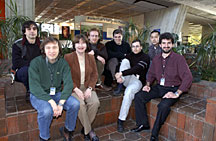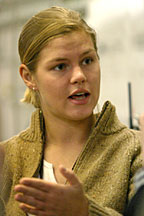Research
Highlights...
|
|
|
SLAC's
Caolionn O'Connell |
|
 |
| Number 154 |
March 22, 2004 |
DOE issues hydrogen pilot plant design report
DOE, through its Advanced Vehicle Testing Activity, has issued a design report for the Arizona Public Service Alternative Fuel (hydrogen) Pilot Plant. The pilot plant in Phoenix is a model alternative fuel refueling system, generating and dispensing hydrogen, compressed natural gas (CNG) and hydrogen/CNG blends (HCNG). The plant is used daily to fuel internal combustion engine vehicles operating on hydrogen and HCNG blends in Arizona Public Service's fleet. The pilot plant, and the hydrogen and HCNG internal combustion engine test vehicles, are operated through a public/private sector partnership agreement between DOE's Advanced Vehicle Testing Activity, Electric Transportation Applications, Arizona Public Service, and DOE's Idaho National Engineering and Environmental Laboratory.
[Steve Zollinger, 208/526-9590;
gaz@inel.gov]
|
|
DZero to B quark: “Tag, you're it!”
 |
| DZero b-tagger team members: (left to right) Lorenzo Feligioni, Alexander Kanov, Flera Rizatdinova, Sebastien Greder, Phillip Shieferdecker, Benoit Clement, Kazu Hanagaki, Ariel Schwartzmann. |
Thanks to a new silicon component, the Run II DZero detector at DOE's Fermilab now has the significant ability to identify or “tag” the decay of b-quarks created in high-energy collisions at the Tevatron collider. Particles containing the b quark can live long enough to escape the fireball of the collision. By providing precision measurements along the trajectory of these long-lived particles, DZero's new silicon microstrip tracker can identify these b-quarks. Identifying b-quarks can help us identify the familiar top quark, the Higgs boson, and even more speculative particles predicted by non-standard models. The DZero group, currently led by Meenakshi Narain of Boston University and Gordon Watts of the University of Washington , has been working two years to develop four different b-tagging algorithms.
[Mike Perricone, 630/840-5678;
mikep@fnal.gov]
|
|
Hot, new microtechnology keeps GI's cool
Personal suits may protect soldiers from chemical and biological weapons, yet without portable cooling technology to ward off heat exhaustion and heat stroke, suits meant to save lives can actually quickly incapacitate soldiers. Researchers at DOE's Pacific Northwest National Laboratory are developing heat-actuated lightweight and compact cooling technology capable of sustaining manageable temperatures within the protective garb for several hours at a time. The principles of microtechnology and the high rates of heat and mass transfer at this miniature scale—about the thickness of the human hair—have enabled “manportable” cooling systems. The systems, which may weigh in at about three to four pounds, will chill water that flows through a vest worn by a solider. Instead of using electricity to power a mechanical compressor, heat from burning fuel is used to power the cooling, thereby replacing bulky, heavy batteries with much lighter fuels.
[Geoff Harvey, 509/372-6083;
geoffrey.harvey@pnl.gov]
|
|
PAD-ding super-thin metal oxide films
Researchers at DOE's Los Alamos National Laboratory have developed a new method for the production of metal oxide films. Called Polymer Assisted Deposition (PAD), the method uses a water-based solution to create a high-quality film of nearly any metal oxide. The films can be made from a single or several different metals with controlled atomic weight relationships. Amorphous, polycrystalline, or epitaxial films can be made with thicknesses from 10 nanometers to hundreds of nanometers or thicker. Using PAD, researchers have produced films of simple metal oxides, such as titanium dioxide and zinc oxide, and complex metal oxides, such as strontium titanate, and indium tin oxide.
[Todd A. Hanson, 505/665-2085;
tahanson@lanl.gov]
|
|
INEEL designing system for Yucca Mountain
DOE's Idaho National Engineering and Environmental Laboratory is designing a prototype, remotely-controlled system that will close spent nuclear fuel containers before they are put into a government disposal repository. Nevada 's Yucca Mountain is being studied as the site for the repository. Engineers are using off-the-shelf equipment in the design. However, the team has had to develop new or modified equipment for some parts of the operation. Philip Wheatley, INEEL's Yucca Mountain relationship manager, said, “We have a proven history of spent fuel canister welding process development. This expertise will help the Yucca Mountain Project and help meet the nation's need for the safe storage of nuclear waste.”
[John Walsh, 208/526-8646;
jhw@inel.gov]
|
|
|
|
Caolionn O'Connell aims
for higher energies
 |
| Caolionn O'Connell |
In between trail-running expeditions through California’s Portola Valley, Caolionn O’Connell can be found luring electrons to surf waves of energy so powerful they rip matter apart. Her group’s prototype technologies boost electrons on waves of plasma traveling at nearly the speed of light as a kind of “plasma afterburner” for existing particle accelerators.
Caolionn is a fourth-year PhD student from Stanford University working at the DOE’s Stanford Linear Accelerator Center. After undergraduate studies at Harvard University and projects at Fermilab’s CDF experiment, she longed for the bright skies and warm weather of her home state. So she returned to California, not one to let travel stand in the way of her passion for the outdoors. Named by her aunt from a traditional Irish fairy-tale, Caolionn jokes that she wishes her name meant “strong and independent woman” rather than the more prosaic but accurate “lass”.
Her project accelerates electrons to much higher energies in much less space than existing technologies. “Fitting new higher energy facilities near existing labs is difficult because of how much room they would take up,” Caolionn says. “Using plasma wakefield accelerators, we will boost electrons to energies 100 times as high in the same space.”
“If we achieve our target acceleration gradients, we could fit an accelerator of SLAC’s energy reach on a tabletop,” Caolionn says, “It is a tremendously exciting project.” sitting outside her control room at the end of the two-mile long SLAC accelerator.
Caolionn’s work on the SLAC E164 and E164X projects will contribute to the “Next Next Linear Collider”, a leapfrogging project that looks beyond the next Linear Collider, top of the DOE’s mid-term priority list for future facilities.
Torn between getting back to her experiment and going running, she resolves to head back to the control room but to find time for physical exertion after the mental exertion of the working day.
Submitted by DOE's
Stanford Linear Accelerator Center
|
|



